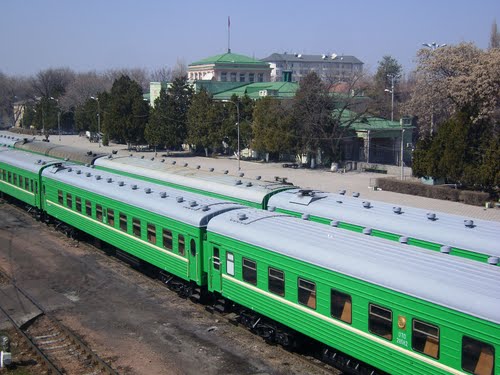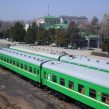
China-Kyrgyzstan-Uzbekistan Railway Scheme: Fears, Hopes and Prospects
Publication: Eurasia Daily Monitor Volume: 9 Issue: 102
By:

“It is not important for China as to who will be building this railway line. The most important thing is that it is built,” Chinese Ambassador to Kyrgyzstan Wang Kaiwen said recently about the China-Kyrgyzstan-Uzbekistan railway project, which Bishkek and Beijing seek to implement despite financial and technical issues (www.aif.kg, April 30). In Kyrgyzstan, the project raises both fears of China’s expansion and hopes that the landlocked republic would finally have a shot at integrating into the global economy. In China, the railway is viewed as a tool to promote cross-continental trade, develop its northwest region and ensure access to economic opportunities in broader Central Asia. If successful, the scheme would lead to major geopolitical ramifications, making regional actors, including Moscow, uneasy as China goes west across Eurasia.
On April 17, Chinese construction corporation CRBC agreed to perform a feasibility study for the project within a year. If built, the railway line would go from Kashgar in Xinjiang, through Torugart and Kara-Suu in Kyrgyzstan, to Andijan in Uzbekistan, then across Afghanistan, Iran and Turkey as far as Europe. The Kyrgyzstan section of the line would cover 268.4 kilometers. China’s section would span 165 kilometers. The cargo transit capacity of the line is expected to be approximately 15,000 tons. The railway is expected to help Kyrgyzstan enhance its position as a transit state in the land-locked region, connect to the Pacific Ocean, and link its economy to that of the outside world. For China, it is projected to complement the overloaded Trans-Siberian and Alashankou corridors, to accommodate its expanding trade across Eurasia, stimulate development of Western provinces and pave the way for further economic inroads into the resource-rich Central Asian region.
The sides are negotiating the width of tracks and forms of financing. China prefers 1,435-millimeter-wide tracks, which are used in Iran and Turkey, because this would allow direct transit and save on delivery times. Kyrgyzstan, however, uses 1,520-mm tracks that it inherited from the former Soviet Union. A railway with Chinese-type tracks traversing Kyrgyzstan, which hosts a Russian military base, is seen as a geopolitical blow to Moscow. The construction of the Turkmenistan-Uzbekistan-Kazakhstan-China gas pipeline in 2009 has already eased Russia’s grip on Central Asia. As a Russian media report put it, “Changes in the transport routes will lead to a realignment of economic links, which will then lead to geopolitical changes” (www.centrasia.ru, April 24).
The talks on the railway scheme come amid tense relations between Russia and Kyrgyzstan. During his visit to Moscow in February, Kyrgyz President Almazbek Atambaev pressed Russian authorities to pay the overdue lease fees for its military base in Kyrgyzstan, pointing to delayed joint projects and China as an available provider of loans and a willing investor in the China-Kyrgyzstan-Uzbekistan railway. The former Kyrgyz President Kurmanbek Bakiev also saw strained ties with Moscow and, during his tenure, looked to Beijing for assistance after failing to receive loans that Russia promised in return for an alleged deal to evict the United States from its base at Manas (www.centrasia.ru, April 24).
There are, however, unresolved financial and potential environmental issues facing the project. In May, Kyrgyzstan rejected the “Resources for Investments” scheme whereby China would get access to a number of mineral deposits in Kyrgyzstan in exchange for a government loan to build the rail line estimated at $2 billion, the equivalent of approximately 74 percent of Kyrgyzstan’s GDP, based on the official exchange rate. Besides being costly, critics fear that such a scheme would lead to an “ecological catastrophe” because areas around the deposits contain approximately 40 percent of all fresh water in Kyrgyzstan. Ambassador Wang purportedly said that China would respect the decision. “We do not have a right to insist. This will then be a purely commercial project based on market principles” (www.tazabek.kg, May 17; www.news-asia.ru, March 30; www.knews.kg, April 10). The sides are considering whether to use a concession for a Chinese company to run the railway for a number of years or to create a joint enterprise in order to finance the project.
China’s regional economic expansion and nascent but rising nationalism in Kyrgyzstan explain the reluctance of Kyrgyzstani authorities to proceed with the “Resources for Investments” scheme. Some in Kyrgyzstan fear that the giant China will devour the tiny Kyrgyzstan, turning it into a Chinatown – a resource base for Chinese labor migrants. Han Chinese are already migrating to Xinjiang in big numbers, creating conditions for a “surplus workforce,” while Uyghurs could yet flee Xinjiang to Central Asia as refugees in case of a major government crackdown (www.kisi.kz, 2011). Moreover, approximately 90,000 Chinese nationals are reportedly staying illegally in Kyrgyzstan already (www.gezitter.org, May 2).
But with threats, come the opportunities. “We should not fear China’s expansion and fence [it] out,” Kyrgyz President Atambaev said, commenting on the project. “We should use to our advantage the fact that China is our neighbor. Even if we do not build the railway, they [the Chinese] will still come to us” (www.regnum.ru, May 3). Ambassador Wang emphasized that as party to the WTO and the SCO, China would like to do more to promote economic cooperation in fields like infrastructure, energy and railway transport (www.russian.china.org.cn, April 28). For China, doing so would speed up the development of its northwest regions, helping it turn Xinjiang into a financial and economic center in the broader region (www.kisi.kz, 2011). For Kyrgyzstan, this would translate into infrastructure development and investment needed to upgrade its fledgling economy following recent political upheavals.
There are more than 100 Chinese businesses in Kyrgyzstan. Many are traders in the largest Central Asian markets, on which Kyrgyzstan has relied to re-export approximately 75 percent of its imported Chinese goods to Russia, Central Asia and beyond. This has created jobs for hundreds of thousands and boosted state revenues. In 2011, trade between China and Kyrgyzstan stood at $5 billion; by 2010, trade between China and Central Asia equaled $23.77 billion (China Daily, May 9; www.centralasiaonline.com, April 28; www.fergana.ru, Nov. 8, 2011; www.pr.kg, May 18).
Unfortunately for Kyrgyzstan, the global financial crisis, political instability, and the launch of the Customs Union (CU) comprising Russia, Kazakhstan and Belarus have reportedly killed a good chunk of the “Silk Road” trade coming out of China through Kyrgyzstan (www.kyrtag.kg, September 27, 2010, December 8, 2011). Russia views the CU as a way to offset Chinese economic expansion and as a step toward the creation of the Eurasian Union, encouraging Kyrgyzstan and Tajikistan to join it (www.rusbiznews.com, May 2). But neither Kyrgyzstan nor Tajikistan rushes to do that. Some studies, including by the Asian Development Bank (ADB), say that joining the CU would increase the price and decrease the amount of goods re-exported from China through Kyrgyzstan to Russia and Kazakhstan (ADB, April 11). The reduction in exports would affect hundreds of thousands of people engaged in trade (www.fergana.ru, November 8, 2011).
The China-Kyrgyzstan-Uzbekistan railway is viewed as a way to help Kyrgyzstan balance Russia’s regional plans. But another railway may help Bishkek do the same regarding China as well. Experts in Russia propose building an Indo-Siberian railway network to promote Russia’s own development and to counter China’s economic influence. The line would connect the Urals, Siberia, Kazakhstan, Kyrgyzstan, Tajikistan, Afghanistan and India. In this scenario, Kyrgyzstan would need to build a railway linking the more urbanized and industrialized north in the Chuy Valley with the more rural and agricultural south in the Fergana Valley (www.kabar.kg, April 20; www.rusbiznews.com, May 2; www.knews.kg, April 20). The violence between Uzbeks and Kyrgyz in the southern city of Osh in 2010 stressed the need for economic integration initiatives to bridge the gap between the relatively poor south and well-off north. Both the North-South and East-West transport initiatives could help Kyrgyzstan integrate from within and without.
As a Central Asian, land-locked, and formerly-Soviet country neighboring China, Kyrgyzstan has no choice but to look to all directions. Kyrgyzstan’s government believes that cooperation with China and the China-Kyrgyzstan-Uzbekistan railway offer just that opportunity, even if both could displease Moscow or domestic critics who fear Beijing’s economic expansion across Eurasia.




